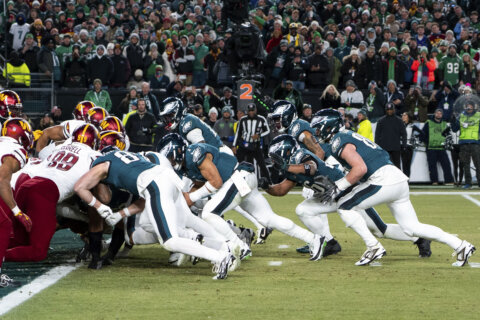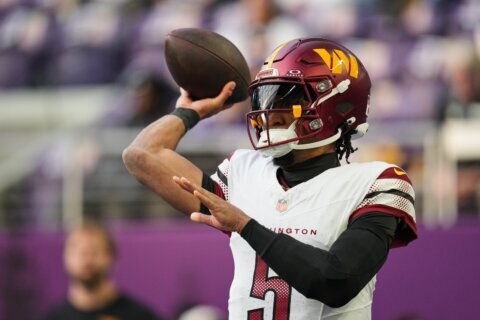This article was republished with permission from WTOP’s news partners at Maryland Matters. Sign up for Maryland Matters’ free email subscription today.
This content was republished with permission from WTOP’s news partners at Maryland Matters. Sign up for Maryland Matters’ free email subscription today.
Former Washington, D.C., Mayor Anthony A. Williams (D), whose municipal reforms and financial stewardship helped spark the capital city’s recovery from junk bond status, often said, “The point of having political capital isn’t to hoard it, it’s to use it.”
Maryland Gov. Lawrence J. Hogan Jr. (R), riding high after securing a second term, appears poised to spend some of his political capital working to keep the Washington Redskins from leaving the state.
The governor has recently provided details about discussions he has had with the Trump administration about a possible land swap that would give Maryland a parcel in Prince George’s County, near the Woodrow Wilson Bridge, that could one day be the site for a new Redskins stadium.
Whether he appreciates it or not, Hogan is hitching his wagon to an enterprise — the Redskins — that is in full-fledged crisis mode. And his strategy appears to rest on the discredited notion that NFL stadiums generate enough economic activity to justify the public investment they require.
When Maryland officials were first wooing the team to the state – at the same time they were scrambling to find a replacement for the recently departed Baltimore Colts, who fled in 1984 – the Redskins were coming off two straight decades of on-the-field success, including a Super Bowl victory as recently as 1992.
That seems like ancient history now.
While the Redskins have a lease on their current stadium, FedEx Field in Landover, that runs through 2027, jockeying has already begun among the likely bidders for a new stadium — Maryland, the D.C. and Northern Virginia.
Hogan and his team know that the window for him to get stuff done is finite, and he’s likely to enjoy more momentum and public support in the upcoming General Assembly session, when he’s fresh off a successful reelection campaign, than at any other time.
But the Redskins are widely viewed to be a dysfunctional mess — a habitual loser on the field, with a remote, isolated owner who is despised, and a fan base that is by turns angry and apathetic.
Consider:
- The team’s attendance collapsed this season, despite the fact that the ‘Skins sprinted to an early lead in their division. Many of the fans who attend Redskins games root for the opposing team. This was particularly true during the team’s final game of the season on Sunday, against the Philadelphia Eagles. As Washington Post columnist Jerry Brewer observed, “There was so much green and black decorating the stadium that, by sundown, the vibe felt dark and ominous.”
- Fewer Redskins fans are watching the club on TV. One week in early December, when the team was still in the playoff chase, there were more viewers for an Eagles-Cowboys game at 4 p.m. in the D.C. market than there were for the ‘Skins tilt three hours earlier. “I remember the days when the Redskins were winning in the ‘80s,” said talk radio host Andy Pollin, a lifelong Washingtonian. “You could roll a bowling ball down Constitution Avenue when the Redskins were playing and not hit a car. Everybody was home watching the game.”
- Washington claimed linebacker Reuben Foster off waivers, just hours after his arrest on domestic violence charges (his third brush with the law in 2018 alone). The Redskins were reportedly the only team willing to gamble on the former Alabama standout. The move angered many fans and intensified public anger at team President Bruce Allen. (When the team’s Twitter account, @Redskins, posted an innocuous photo of the club’s Week 17 uniforms, hundreds of fans taunted the club with “#FireBruceAllen” in response.)
- For years, the Redskins falsely boasted they had a season-ticket waiting list. Faced with the reality — that most games are played in a partially-filled stadium — the club removed thousands of seats, to make the stadium seem less empty.
- A highly-regarded NFL executive, Brian Lafemina, lured to D.C. in 2018 to improve the gameday experience for fans at FedEx Field, was fired last week, along with the assistants he brought with him. Having been promised “1,000 days” to restore the team’s connection to its fans, he was let go after less than nine months on the job. “It seems like they’ve been giving the fan base the middle finger,” said Pollin. “It’s more than an angry fan base. It’s an apathetic fan base, which for business is a very bad thing. And I’m really amazed by that.”
While journalists and fans differ on what the Redskins should do to bring back the magic that accompanied the team’s heyday, it’s an article of faith that owner Daniel Snyder is a toxic mix of incompetent, aloof and tone-deaf.
The Redskins have missed the playoffs 15 of the 20 years he’s owned the team. They have won just one playoff game during his tenure. And they are the only team in the NFL not to have at least one 11-win season since 2001.
A recent New York Times article declared that, “The federal government is perhaps the rare entity in the nation’s capital that is more dysfunctional than the region’s pro football team.”
Washington Post columnist Thomas Boswell told readers this week in an online chat that “there is no end in sight” to the team’s dysfunction. Because of the owner, he said, “There is no reason to have hope.”
Hogan has defended his strategy for keeping the Redskins in Maryland. He recently told reporters that the state will not have to pay for stadium land because of his negotiations with Interior Secretary Ryan Zinke (who has since left his post). The state would swap land it owns in Western Maryland, near historic Civil War sites, in exchange for the land in Prince George’s that Hogan is envisioning for a football stadium.
But the governor stressed that he has no intention of having the state build the stadium.
“We’re not going to build a billionaire a stadium,” he declared at a Dec. 11 news conference. “We have no interest whatsoever — and there’s been no discussions, ever — about us spending one penny on construction.”
But that leaves the infrastructure costs. Hogan will have to make the case — with the General Assembly and the public — that connecting the Oxon Cove land he is eyeing to nearby roads (the Capital Beltway, MD 210 and DC 295) and, possibly, a Metro extension across the Woodrow Wilson Bridge, would be a prudent use of taxpayer money.
It won’t be easy, in part because Hogan will be advocating alongside an entity that retains little of its once massive store of public good will.
House Speaker Michael E. Busch (D-Anne Arundel) has already expressed reservations about such expenditures, and others are likely to do the same.
“It’s a significant amount of state money that would be required to deal with the infrastructure challenges of that location,” said University of Mary Washington political science professor Stephen Farnsworth.
“It’s important to remember, an NFL stadium is not like a [baseball] ballpark. You have 80 home games versus eight. You would have 350 days to find another use for that facility. That will be a daunting task for that location.”
In addition, Farnsworth said, lawmakers will vigorously push for other uses of those dollars.
“If you look at educational needs in Maryland, if you look at bus service, if you look at redevelopment in places that are seeing tough economic times, there is a case to be made that all of these are better uses of taxpayer money than enriching one of the richest men in Washington.”
Added Pollin: “People used to say, ‘Well, it’s going to provide a lot of jobs.’ They’ve done studies on that, and it really doesn’t boost the economy that much. You’re talking about people who work on a day basis. They make a couple hundreds of dollars for working a football game. That’s not going to change things.”
“Maryland will end up paying more than it’s worth to keep this team,” Farnsworth predicted. “Or somebody else — Virginia or D.C. — will pay more than it’s worth to get this team. Either way, Dan Snyder has a winning bottom line, even if he doesn’t have a winning record.”
Farnsworth noted that the Baltimore Colts’ decision to leave for Indianapolis in the middle of the night still stings for many old-time Marylanders. For that reason, he said, Hogan has to be vigorous in his campaign to keep the Redskins, even if it doesn’t pan out.
“It’s always tough for an elected official to be at the helm when a team chooses to move,” he said. “That’s why Hogan is going to make the effort. The governor has to try.”
Bruce DePuyt spent more than two decades on local television, including 14 years as host of News Talk on NewsChannel 8 in the D.C. metro region. He has served as reporter, anchor and producer/host of 21 This Week in Montgomery County, as well as a reporter/anchor at NBC affiliate WVIR-TV in Charlottesville, VA. Bruce also is the host of the weekly The Bruce DePuyt Podcast.







